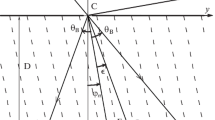Abstract
Bragg and Laue diffraction methods can be combined to study the refractive index and structure factor of polycrystalline and crystalline thin metal wedges, within 1%, using anomalous transmission of travelling X-ray waves in a thick perfect single crystal of silicon {110}. Anomalous transmission occurs in a thick defect free absorbing crystal when the diameter point on the alpha branch is excited by a parallel beam of monochromatic X-rays. Travelling wave of σ polarisation connected to this point and the nearby Laue point has antinodes between the diffracting lattice planes and suffers much smaller absorption than in the normal case (μ 0 t = 15), in going through a thick silicon perfect crystal. This method shows how by introduction of a thin wedge one can produce and measure (in absolute units) the shift in the position of Bragg and Laue diffracted Mo K(α) (17.4 keV) X-rays. Using Mo K(α) which has a low Bragg angle and a Si {220} symmetrical reflection, thin wedges can be sampled. The position of Bragg and Laue peaks from the centre of the rocking curve and the introduced change (in arcsec) gives refractive index and structure factor valueF 0 of the test wedge. The index of refraction parameter 1−n of a 21.2° aluminium wedge was determined experimentally as 1.7×10−6.
Similar content being viewed by others
References
B. W. Batterman andH. Gole, Rev. Mod. Phys.,36, 681, 1964.
R. W. James, The Optical Principles of the Diffraction of X-rays, G. Bell & Sons, London, 1960.
L. V. Azaroff, R. Kaplow, N. Kato, R. J. Weiss, A. J. C. Wilson andR. A. Young, X-ray Diffraction, McGraw Hill Book Company International Series, in Pure and Applied Physics, New York, 1974.
M. Reninger, Z. Naturforsch.,16a, 110, 1961.
S. K. Andersen, P. K. Bhattacharya, J. Golovchenko, N. Hertel andG. Mair, J. Phys. E- Sci. Instrum.,12, 1063, 1979.
F. O. Eiramdshyam, T. O. Eiramdshyam andP. A. Bosirgauyam, Izo. Akad. Nauk. Arm. SSR Fiz. Mat.,9, 477, 1974.
U. Bonse andH. Hellkoter, Z. Physik.,233, 345, 1969.
D. C. Creagh, Austral. J. Phys.,28, 543, 1975.
D. C. Creagh andM. Hart, Phys. Status Solidi.,37, 753, 1970.
B. Okkerse, Philips Res. Rep.,20, 377, 1965.
Author information
Authors and Affiliations
Additional information
This work was done at the Institute of Physics, University of Aarhus, DK-8000, Aarhus C, Denmark.
Rights and permissions
About this article
Cite this article
Bhattacharya, P.K. Absolute measurement of refractive index and structure factor in polycrystalline and crystalline wedges using anomalous X-ray transmission in perfect crystals. Acta Physica 50, 313–320 (1981). https://doi.org/10.1007/BF03157893
Received:
Issue Date:
DOI: https://doi.org/10.1007/BF03157893



